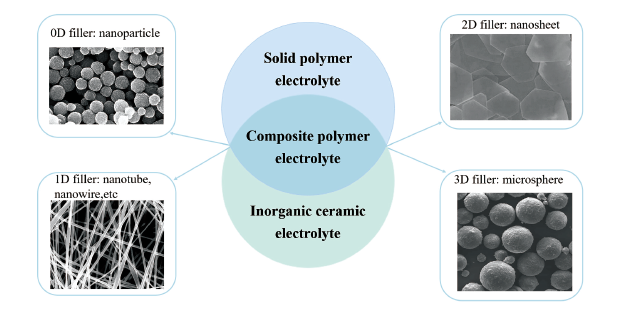 PDF(8569 KB)
PDF(8569 KB)


Composite Polymer Electrolytes with Multi-Dimensional Non-Lithium Inorganic Hybird Components for Lithium Batteries
Bingyi Ma, Sheng Huang, Shuanjin Wang, Min Xiao, Dongmei Han, Yuezhong Meng
Prog Chem ›› 2023, Vol. 35 ›› Issue (9) : 1327-1340.
 PDF(8569 KB)
PDF(8569 KB)
 PDF(8569 KB)
PDF(8569 KB)
Composite Polymer Electrolytes with Multi-Dimensional Non-Lithium Inorganic Hybird Components for Lithium Batteries
The traditional electrolyte is flammable, easy to leak, and toxic, which affects the safety performance of batteries working for a long time. In view of the above problems, recently researchers have focused on the development of (quasi) solid electrolyte. Solid composite electrolyte composed of inorganic fillers and polymer has the advantages of high ionic conductivity and mechanical stability of inorganic electrolyte, flexibility and low interface impedance of polymer electrolyte, which has attracted extensive attention of researchers. Inorganic components mainly include active Li+-containing fillers and inert Li+-free fillers. The inert Li+-free fillers possess the benefits of low cost and easy preparation process, so they have greater potential for large-scale industrial applications. In this paper, the performance requirements of composite polymer electrolytes are reviewed. Starting from non-lithium inorganic hybrid components, we summarize the research on improving the performance of composite polymer electrolyte with inert Li+-free fillers, including zero-dimensional nanoparticles, one-dimensional nanotubes (nanowires, nanorods), two-dimensional boron nitride nanosheets, and three-dimensional structure of fillers. Different dimensions of analysis and thinking aim to shed light on the design and application of inert fillers-polymer electrolytes, and we also look forward to the broad prospects of non-lithium inorganic components in the industrial application of composite electrolyte.
1 Introduction
2 Performance requirements
2.1 High ionic conductivity
2.2 High lithium-ion transference number
2.3 Wide electrochemical stability window
2.4 Mechanical strength
2.5 Thermal and chemical stability
3 Multi-dimensional non-lithium inorganic hybrid component
3.1 Zero-dimensional nanoparticles
3.2 One-dimensional nanostructure
3.3 Two-dimensional nanosheet
3.4 Three-dimensional strucutre
4 Conclusion and outlook

composite-polymer electrolyte / inert Li+-free fillers / multi-dimensional / ionic conductivity / electrochemical performance
| [1] |
|
| [2] |
|
| [3] |
|
| [4] |
|
| [5] |
|
| [6] |
|
| [7] |
|
| [8] |
|
| [9] |
|
| [10] |
|
| [11] |
|
| [12] |
|
| [13] |
|
| [14] |
|
| [15] |
|
| [16] |
|
| [17] |
|
| [18] |
|
| [19] |
|
| [20] |
|
| [21] |
|
| [22] |
|
| [23] |
|
| [24] |
|
| [25] |
|
| [26] |
|
| [27] |
|
| [28] |
|
| [29] |
|
| [30] |
|
| [31] |
|
| [32] |
|
| [33] |
|
| [34] |
|
| [35] |
|
| [36] |
|
| [37] |
|
| [38] |
|
| [39] |
|
| [40] |
|
| [41] |
|
| [42] |
|
| [43] |
|
| [44] |
|
| [45] |
|
| [46] |
|
| [47] |
|
| [48] |
|
| [49] |
|
| [50] |
|
| [51] |
|
| [52] |
|
| [53] |
|
| [54] |
|
| [55] |
|
| [56] |
|
| [57] |
|
| [58] |
|
| [59] |
|
| [60] |
|
| [61] |
|
| [62] |
|
| [63] |
|
| [64] |
|
| [65] |
|
| [66] |
|
| [67] |
|
| [68] |
|
| [69] |
|
| [70] |
|
| [71] |
|
| [72] |
|
| [73] |
|
| [74] |
|
| [75] |
|
| [76] |
|
| [77] |
|
| [78] |
|
| [79] |
|
| [80] |
|
| [81] |
|
| [82] |
|
| [83] |
|
| [84] |
|
| [85] |
|
| [86] |
|
| [87] |
|
| [88] |
|
| [89] |
|
| [90] |
|
| [91] |
|
| [92] |
|
| [93] |
|
| [94] |
|
| [95] |
|
| [96] |
|
| [97] |
|
| [98] |
|
| [99] |
|
| [100] |
|
| [101] |
|
| [102] |
|
| [103] |
|
/
| 〈 |
|
〉 |